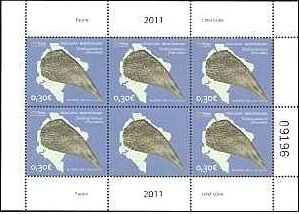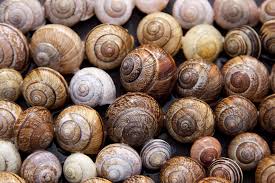Mini Sheet: Noble Pen Shell (Pinna nobilis) (Montenegro 2011)
Noble Pen Shell (Pinna nobilis) (Montenegro 2011)
17 March (Montenegro ) within release Fauna (2011) goes into circulation Mini Sheet Noble Pen Shell (Pinna nobilis) face value 5*0.30 Euro
| Mini Sheet Noble Pen Shell (Pinna nobilis) in catalogues | |
|---|---|
| Michel: | Mi: ME 260KB |
Mini Sheet is square format.
Also in the issue Fauna (2011):
- Mini Sheet - Alpine Newt (Triturus alpestris montenegrinus) face value 5*0.30;
- Mini Sheet - Dalmatian Pelican (Pelecanus crispus) face value 5*0.40;
- Mini Sheet - Noble Pen Shell (Pinna nobilis) face value 5*0.30;
- Mini Sheet - Pygmy Cormorant (Phalacrcorax pygmeaus) face value 5*0.90;
Mini Sheet Noble Pen Shell (Pinna nobilis) it reflects the thematic directions:
Animals are multicellular, eukaryotic organisms of the kingdom Animalia (also called Metazoa). All animals are motile, meaning they can move spontaneously and independently, at some point in their lives. Their body plan eventually becomes fixed as they develop, although some undergo a process of metamorphosis later on in their lives. All animals are heterotrophs: they must ingest other organisms or their products for sustenance.
A map is a symbolic depiction emphasizing relationships between elements of some space, such as objects, regions, or themes. Many maps are static, fixed to paper or some other durable medium, while others are dynamic or interactive. Although most commonly used to depict geography, maps may represent any space, real or imagined, without regard to context or scale, such as in brain mapping, DNA mapping, or computer network topology mapping. The space being mapped may be two dimensional, such as the surface of the earth, three dimensional, such as the interior of the earth, or even more abstract spaces of any dimension, such as arise in modeling phenomena having many independent variables. Although the earliest maps known are of the heavens, geographic maps of territory have a very long tradition and exist from ancient times. The word "map" comes from the medieval Latin Mappa mundi, wherein mappa meant napkin or cloth and mundi the world. Thus, "map" became the shortened term referring to a two-dimensional representation of the surface of the world.
Marine life, or sea life or ocean life, refers to the plants, animals and other organisms that live in the salt water of the sea or ocean, or the brackish water of coastal estuaries. At a fundamental level, marine life helps determine the very nature of our planet. Marine organisms produce much of the oxygen we breathe. Shorelines are in part shaped and protected by marine life, and some marine organisms even help create new land. Altogether there are 230,000 documented marine species, including over 16,000 species of fish, and it has been estimated that nearly two million marine species are yet to be documented. Marine species range in size from the microscopic, including plankton and phytoplankton which can be as small as 0.02 micrometres, to huge cetaceans (whales, dolphins and porpoises) which in the case of the blue whale reach up to 33 metres (109 feet) in length, being the largest known animal.
A seashell or sea shell, also known simply as a shell, is a hard, protective outer layer created by an animal that lives in the sea. The shell is part of the body of the animal. Empty seashells are often found washed up on beaches by beachcombers. The shells are empty because the animal has died and the soft parts have been eaten by another animal or have rotted out. The term seashell usually refers to the exoskeleton of an invertebrate (an animal without a backbone). Most shells that are found on beaches are the shells of marine mollusks, partly because many of these shells endure better than other seashells.




